The Adventures of St Ivel

The famous St. Ivel brand originated with Aplin & Barrett, dairy produce manufacturers of Yeovil (est. 1888). According to a brand historian it was Mr Barrett, a company director, who decided at around the turn of the century that the business needed a suitably impressive back story or gimmick for promotional purposes. He therefore invented a tale about a group of monks who lived near the River Yeo in Somerset and kept recipes for various table delicacies (M. Stiling,
Famous brand names, emblems and trade-marks). The name of the firm’s fictional saint was taken from ‘Ivel’ which was one of the historical spellings accorded to the town of Yeovil (source:
Yeovil History).
A newspaper advertisement from 1st November 1901 described how Aplin & Barrett’s new product was introduced to the public: ‘We have for the past three years been trying to produce the famous cheese made originally by the Monks of St. Ivel, and have only recently discovered the secret. The Cheese is soft and very rich, like a Cream Cheese, but instead of being tasteless or curdy, it has the delicious flavour of a Fine Old Cheddar, a combination which cannot be found in any other cheese. We had the St. Ivel Cheese on view for the first time at the London Dairy Show, 1901, where thousands tasted them, and one and all pronounced them perfect’ (source:
Kings Lynn History).
Aplin & Barrett also sold a variety of other products including pies, potted pastes and puddings. A 1905 press article on ‘Stir-Up Sunday: Decline and Fall of Home-Cooked Christmas Puddings’ referred to the current popularity of Aplin & Barrett’s festive offering which came ready cooked in basins: ‘St. Ivel plum puddings are increasing in popularity, and larger numbers even than last year are being made. The puddings are so popular that they are for sale in London tea-shops’ (
The Daily Mirror, 20 November 1905). An advert for St. Ivel Christmas puddings in The Graphic illustrated newspaper featured Santa Claus and a group of children about to tuck into the product and recommended pairing with St. Ivel’s Devonshire Clotted Cream (‘Everything St. Ivel is perfect’). The ad also noted that the brand’s mincemeat was as good as the pudding (
The Graphic, 16 December 1905).
At the end of 1907 a whole-page text only ad for St. Ivel Christmas Plum Puddings and other comestibles appeared in the daily press which was hung on a rather tenuous topical peg – ‘Result of the German Emperor’s Visit. Peace and Goodwill!!’ (Referring to the recent state visit of Kaiser Wilhelm II to Britain). On closer inspection ‘Peace and Goodwill’ was also declared to be the happy result of selecting a St. Ivel plum pud for the festive table:
‘PEACE because no trouble in Making, No trouble in Cooking, No fear of not Turning Out Well
GOODWILL because being scientifically made, they are easily digested and Perfect Health and Goodwill wait on Good Digestion’ (
The Advertising World, January 1908).
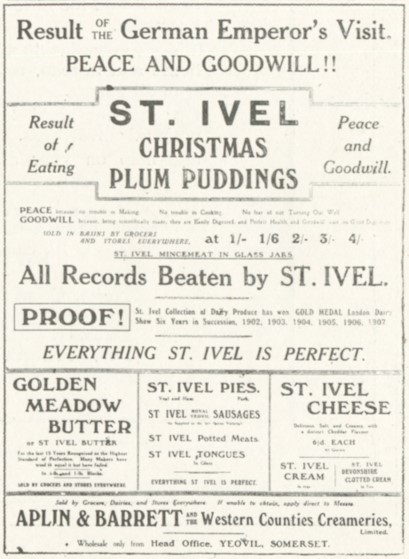
Advert for St. Ivel Christmas Puddings, reproduced in The Advertising World, January 1908
In 1909, a light-hearted serial (‘The
Adventures of St. Ivel’) appeared in the London press, which, in just four months, was credited with boosting sales of St. Ivel Cheese by a very impressive 250%. The advertising industry’s trade journal observed approvingly of the new campaign: ‘The value of the series lies wholly in their humour, and before the advertiser can afford to be funny about his goods he must have their name and character pretty well known to the public. Granted that the manufacturers of “St. Ivel” Cheese have complied with these conditions, the advertisement is excellent. Each uses a well-known public figure as a foil to the central character of the imaginary St. Ivel, and witty, topical allusion will always have a multitude to relish it…The “St. Ivel” advertisements, it should be noted, are illustrated by a well-known draughtsman, and the text is evidently written by a man who is practiced in writing’ (
The Advertising World, August 1909). The figure of St. Ivel in the press advertising adventure serial was drawn by Alexander ‘Alick’ P.F. Ritchie, a well-known commercial artist and cartoonist. Another version of the chevalier saint (‘The Pride of the West Countrie’) was designed later by the artist S.E. Scott in an advert for St. Ivel’s Lactic Cheese.
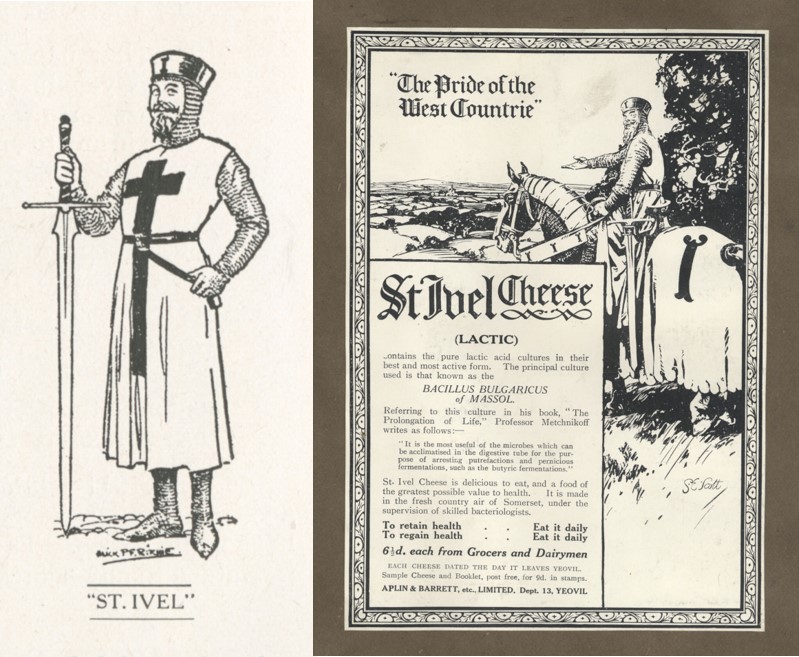
Two versions of 'St. Ivel'
A review of current press advertising towards the end of 1909 noted that St. Ivel had been referenced in a sketch by George Robey, the famous London music-hall comedian (who was also a popular pantomime player). Robey appeared at the Tivoli Theatre ‘in the costume of a Crusader and asking his audiences whether they take him for “St. Ivel” Cheese…The fact is remarkable, because the St. Ivel red cross knight has not been appearing in the Press very long, and certainly not long enough, one might imagine, to suppose that the public would recognise any allusion to him outside the domain of pure advertisement’ (
The Advertising World, November 1909). It was reported that the Aplin & Barrett firm had returned the compliment by creating an advertisement from Mr Robey’s adaptation of their brand’s saintly mascot.
The Advertising World journal provided more background on the origins of St. Ivel’s frontman in a later feature on the contemporary proliferation of advertising mascots: ‘Some years ago, when St. Ivel Cheese was first introduced to the public, Messrs. Aplin and Barrett used the figure of a monk to typify the name St. Ivel, but it was suggested to them by their solicitors that this might give the public the idea that St. Ivel Cheese was of monastic origin, and they consequently changed the figure of the monk for the familiar Crusader which is used to-day. A very successful Crusader he has proved too!’ The article went onto note the issue of a promotional booklet by Aplin & Barrett entitled ‘The
Adventures of St. Ivel’ (a compilation of their recent press advertising referred to previously), which followed the cheese champion’s progress around the world and related his encounters with contemporary personages such as Mr. Lloyd George, the Kaiser, Wilkie Bard (a popular vaudeville entertainer), George Bernard Shaw and a group of Suffragettes - ‘To each and all St. Ivel pauses to enforce the lesson that the cheese, whose name he bears, is the only indispensable requisite in the larder of every household’ (
The Advertising World, February 1911).
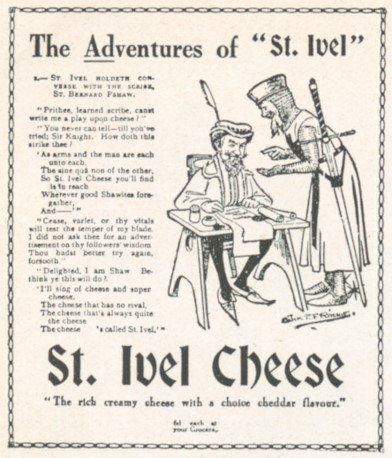
From 'The Adventures of St. Ivel' featuring St Bernard Pshaw (The Advertising World, Aug. 1909)
Messrs. Aplin and Barrett’s wide range of products also included Ivelcon, a beef extract food beverage in cube form (‘The Ideal St. Ivel Consomme’). The festive season of 1910 saw a jolly Ivelcon Christmas Pantomime of ‘St. Ivel & The Dragon’, in the shape of a press advert, which earned plaudits for its authentic and lively feel - ‘The dialogue is written in true pantomime jingle in rhymed couplets which properly preserve a tradition that is in danger of being treated with some disrespect elsewhere’. The dramatis personae included St. Ivel (‘The Good Fairy’) and the Demon Bacillus (alias the dragon) plus a sprinkling of barely disguised contemporary personalities such as ‘Sir Herbert Tr-e, Principal Boy’ and ‘Miss Christabel P-nkh-rst, Principal Girl’ - with the action taking place in a Rural Glade in Somersetshire. It was noted of this ‘Potted Pantomime’ that: ‘The play reads like nothing more than an outburst of good-humoured high spirits from its beginning to the truly impressive climax’ when St. Ivel finally vanquishes the Demon Bacillus in true pantomime style with the words ‘Get hence, Bacillus, for your day has gone, ‘Tis vain to try to cope with Ivelcon’’ (
The Advertising World, January 1911). The article, entitled ‘Ivelcon Ingenuities’, further observed that if humour could answer the advertiser’s purpose then Aplin & Barrett may be credited with producing ‘some of the most brilliant advertising that has lately made its appearance’.
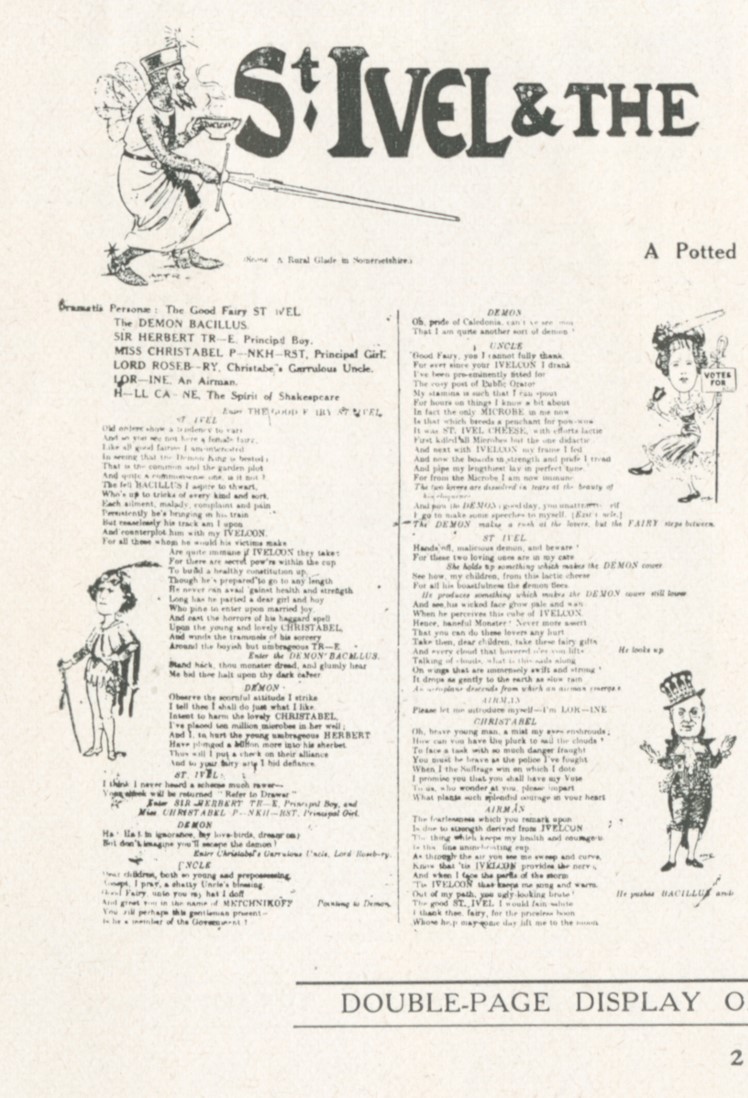
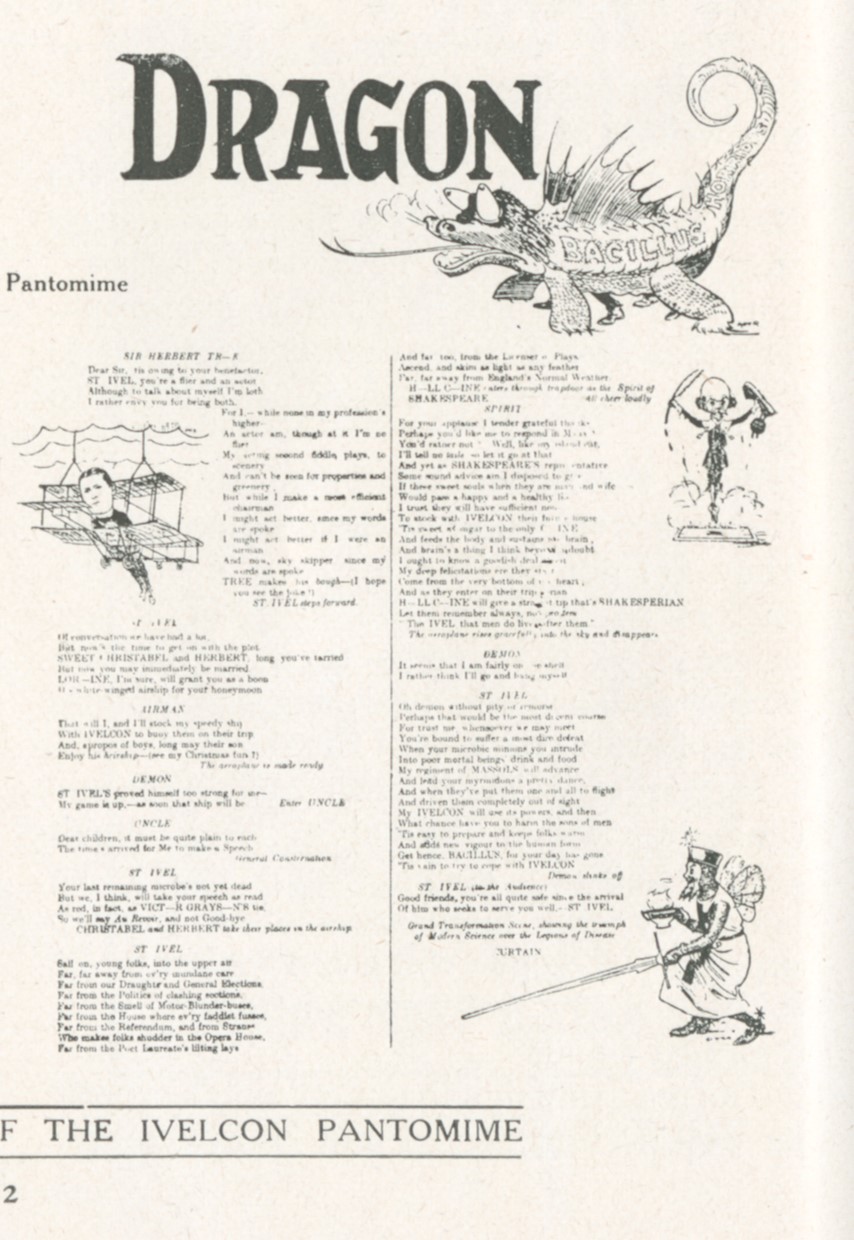
Double-page Ivelcon Pantomime (The Advertising World, Jan. 1911)
Aplin & Barrett also issued an Ivelcon New Year announcement, featuring the traditional figure of Father Time, to celebrate the arrival of 1911: ‘The motive upon which the page was built is enshrined in the quatrain:
Howe’er your New Year resolutions vary
Here’s one to make and keep this January:
That as the seasons pass and months go on,
You’ll greet and speed them all with Ivelcon’.
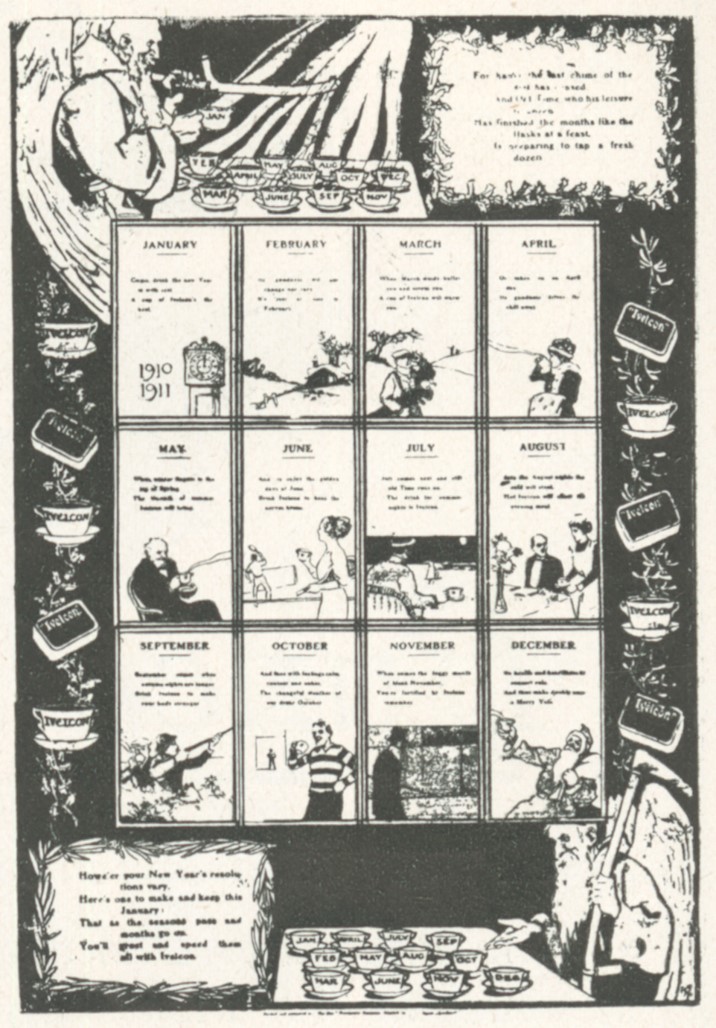
Ivelcon New Year page, The Advertising World, Feb. 1911
Eve Read
Archive Collections Manager
« All News Articles